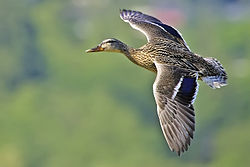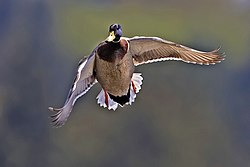Flight
Flight is the process by which an animal or object achieves sustained movement either through the air by aerodynamically generating lift or aerostatically using buoyancy, or movement beyond earth's atmosphere, in the case of spaceflight.
Animal flight


The most successful groups of living things that fly are insects, birds, and bats. Each of these groups' wings evolved separately from different structures. See also Bird flight.
Pterosaurs were a group of flying vertebrates contemporaneous with the dinosaurs.
Bats are the only mammals capable of true flight. However, there are several gliding mammals which are able to glide from tree to tree using fleshy membranes between their limbs; some can travel hundreds of metres in this way with very little loss in height. Flying tree frogs use greatly enlarged webbed feet for a similar purpose, and there are flying lizards which employ their unusually wide, flattened rib-cages to the same end. Certain snakes also use a flattened rib-cage to fly, with a back and forth motion much the same as they use on the ground.
Flying fish can glide using enlarged wing-like fins, and have been observed soaring for hundreds of metres using the updraft on the leading edges of waves. It is thought that this ability was chosen by natural selection because it was an effective means of escape from underwater predators.
Most birds fly (see bird flight), with some exceptions. The largest birds, the ostrich and the emu, are earthbound, as were the now-extinct dodos, while the non-flying penguins have adapted their wings for use under water. Most small flightless birds are native to small islands, and lead a lifestyle where flight would confer little advantage. The Peregrine Falcon is the fastest animal in the world; its terminal velocity exceeds 370 km/h (199 mph) in a dive.
Among living animals that fly, the wandering albatross has the greatest wingspan, up to 3.5 metres (11.5 feet); the great bustard has the greatest weight, at around 21 kilograms (46 pounds)[1].
Among the many species of insects, some fly and others do not (See insect flight).
Mechanical flight
Mechanical flight is the use of a machine, called an aircraft, to fly. These machines include helicopters, autogyros, airships, balloons, and spacecraft. Gliders provide unpowered flight. Another form of mechanical flight is parasailing. This occurs by a parachute like object being pulled by a boat.
The most common form of mechanical flight is aeroplane flight. Several steps are involved:
See aviation history and First flying machine for the history of mechanical flight.
Forces in Flight
Several forces are particularly important for flight:
- Propulsive thrust: (except in gliders)
- Lift: Created by wings
- Drag: Created by airflow
- Weight: (created by gravity)
- Buoyancy: for lighter than air flight
In fiction
In fiction, particularly fantasy, science fiction and comic books, many characters have the ability to fly without a vehicle, often attributed to supernatural or paranormal explanations.
- Dumbo, the Disney-created elephant, employs his comically oversized ears as wings for flight.
- Western dragons are depicted with wings.
- Superman is a superhero in comic books, cartoons, and films; flight is among the various superpowers he is portrayed to obtain from the yellow rays of earth's sun. Most fictional comic book superheroes are said to fly by willpower or by telekinetically levitating themselves. Jean Grey of the X-Men, for example, uses telekinesis to levitate above ground. Storm of the X-Men flies by controlling the weather in her immediate vicinity. Magneto flies by magnetically levitating the metal suit he wears. Also, some superheroes have wings, rather than willpower. For example, Archangel from the X-Men flies thanks to two feathery wings that come out of his back. Angel Salvadore, a former member of X-Men who is currently de-powered, originally had insectoid wings that allowed her to fly.
- In the 1995 film Slam Dunk Ernest, Jim Varney's trademark character is granted the gift of flight by Kareem Abdul-Jabbar.
- Santa Claus has a sleigh pulled by flying reindeer.
- In the Hitchhiker's Guide to the Galaxy books, Arthur Dent accomplishes flight by throwing himself at the ground and missing.
- Pegasus was a winged horse in Greek mythology who appears in, among other things, the 1980s film Clash of the Titans.
- In Bionicle storyline, a Kanohi mask called Kadin allows the user the ability to fly.
- In the very popular Japanese manga TV Show Dragonball Z, many of the characters have the ability to fly after they have mastered their Ki (energy)
- In the TV series Heroes one of the main characters, Nathan Petrelli, has the ability to fly
- Miles "Tails" Prower uses his two tails to propel himself and maintain temporary flight over short distances.

See also
- Early aviation pioneers
- Abbas Ibn Firnas
- Armen Firman
- Jean-Marie Le Bris
- George Cayley
- Hezarfen Ahmet Celebi
- Lagari Hasan Çelebi
- Félix du Temple de la Croix
- Amelia Earhart
- Eilmer of Malmesbury
- Bartolomeu de Gusmão
- Otto Lilienthal
- Charles Lindbergh
- Lu Ban
- Alexander Mozhaisky
- Richard Pearse
- Charles Renard
- Helen Richey
- Alberto Santos-Dumont
- John Stringfellow
- Emmanuel Swedenborg
- Wright Brothers
- Methods of Attaining Flight
- Other topics
External links
- 'Birds in Flight and Aeroplanes' by Evoluntionary Biologist and trained Engineer John Maynard-Smith Freeview video provided by the Vega Science Trust.
- Early flight - State Library of NSW
